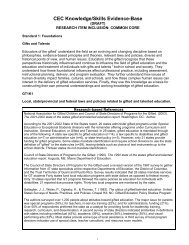Advanced Readers At Risk: Rescuing an Underserved ... - NAGC
Advanced Readers At Risk: Rescuing an Underserved ... - NAGC
Advanced Readers At Risk: Rescuing an Underserved ... - NAGC
You also want an ePaper? Increase the reach of your titles
YUMPU automatically turns print PDFs into web optimized ePapers that Google loves.
Jacob K. Javits Gifted <strong>an</strong>d Talented Students Education Program<br />
The Schoolwide Enrichment Model in Reading (SEM-R)<br />
Summary of the Gr<strong>an</strong>t<br />
Project Name: The Schoolwide Enrichment Reading Model (SEM-R)<br />
Focus: Elementary <strong>an</strong>d Middle, Two Separate Gr<strong>an</strong>ts: Funded in 2004 <strong>an</strong>d 2009<br />
Grade Level: Grades 2-8<br />
Contact Information: Sally M. Reis, Ph.D., University of Connecticut,<br />
sally.reis@uconn.edu; www.gifted.uconn.edu/semr<br />
States Served by the Project: CT, NC, MD, MN, CA, CO, LA, FL, NY, OH, IL<br />
A Case Study<br />
During the last eight years, in several urb<strong>an</strong>, high poverty elementary <strong>an</strong>d middle schools across the<br />
country, <strong>an</strong> alternative approach focusing on engagement <strong>an</strong>d enjoyment of reading has been used<br />
instead of traditional reading instruction has occurred on a daily basis. The Schoolwide Enrichment<br />
Reading Framework (SEM-R), funded by Javits, is a different approach to reading instruction for high<br />
poverty students. Instead of using basal readers <strong>an</strong>d workbooks, SEM-R using the SEM-R are exposed<br />
to high interest books <strong>an</strong>d choose to read in their areas of interest as long as the books are challenging<br />
<strong>an</strong>d above their current level of reading. High interest libraries are provided for every classroom <strong>an</strong>d the<br />
focus is on enjoyment in <strong>an</strong>d students learn to love to read. In the SEM-R, students’ strengths <strong>an</strong>d<br />
interests are <strong>an</strong>alyzed <strong>an</strong>d reading instruction is delivered through the use curricular differentiation (both<br />
acceleration <strong>an</strong>d enrichment) as well as instructional differentiation. The goal of the SEM-R is increased<br />
student reading fluency <strong>an</strong>d comprehension, as well as enjoyment <strong>an</strong>d self-regulation in students who are<br />
at greatest risk of developing reading problems or becoming alliterate, that is, being able to read but<br />
choosing not to read.<br />
The instructional design calls for three phases of instruction:<br />
Phase I - Exposure<br />
• Teachers select literature to read aloud to students, interspersed with higher-order questioning <strong>an</strong>d<br />
thinking skills instruction.<br />
These "book hook" sessions are initially 10 to 20 minutes in length, <strong>an</strong>d teachers are encouraged to share<br />
high interest, challenging books with their students. A variety of genres c<strong>an</strong> be selected for this phase<br />
including mysteries, poetry, historical <strong>an</strong>d science fiction, biographies, autobiographies, <strong>an</strong>d other nonfiction.<br />
The program emphasizes helping students to enjoy the process of reading. Teachers are provided<br />
with bookmarks that feature guiding questions involving higher order thinking skills to help them frame the<br />
class discussion for the read aloud.<br />
Phase II – Training <strong>an</strong>d Self-Selection<br />
• The development of students' capability to engage in a structured silent reading time of self-selected<br />
high interest books is emphasized in this phase.

















